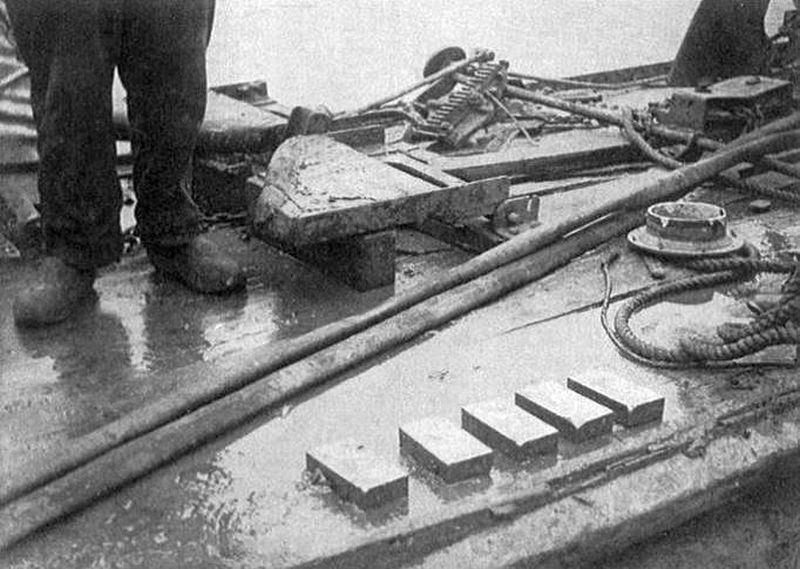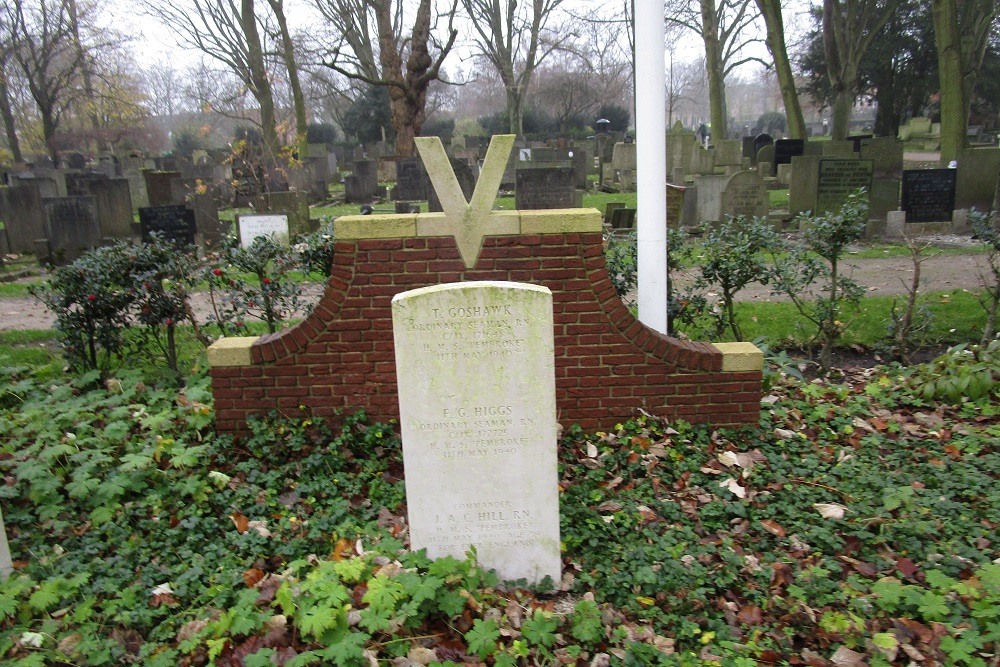Introduction
On the eve of the Second World War, the German government had assured the Dutch that they would respect their neutrality. The Dutch government, however, did not trust this assurance, and the near future would prove that the Dutch preparatory measures had not been in vain. One of these measures was to secure the Nederlandsche Bank’s (Dutch national bank) gold deposit. From September 1938, it had over 362 tonnes (399 US tons/ 356 imperial tons) of gold transferred to New York, London, and Pretoria.
One year later, there were clear signs that Germany, despite all their reassurances, was going to invade the Netherlands on November 11th 1939. PM De Geer was quick to reassure the Dutch people that they were not in danger, and that the Germans would surely respect their neutrality. The Nederlandsche Bank, however, thought differently, after the general mobilisation in August. Management made plans to secure the rest of the gold deposit, which was stored at the main office in Amsterdam and at the Bijbank kbranch office) at the Boompjes in Rotterdam. The bank contacted the Dutch and British navies to escort the cargo ships, and had the gold stored in crates. The Dutch government, however, prevented the transport, so as not to provoke the Germans. The Netherlands were to stay neutral at all costs.
On May 10 1940, at 3.55 am, German fighter planes blew Dutch neutrality to smithereens. The enemy fighters initially crossed the country, to the great relief of its inhabitants, and they headed for England, only to make a 180° turn at sea and drop bombs and parachutists in Dutch airspace anyway. Rotterdam shortly became the centre stage for fierce battles. Waalhaven Airport was bombed, and heavy fighting broke out between German parachutists, the Dutch Royal Navy, and some navy ships right outside the Bijbank at the Willemsbrug (bridge) and the Boompjes.
From the get-go, the Rotterdam branch of the national bank became a death trap. In front of the building, German machine guns shot anything that moved, behind it the Dutch military were taking up positions. The Rotterdam bank management feverishly debated how to secure over 113 tonnes (124 US tons/ 111 imperial tons) of gold, which had been neatly returned to its shelves in the autumn of 1939. Things were much easier for the bank in Amsterdam, where fighting had not yet broken out. It was relatively easy to transport the crates with 78 tonnes (85 US tons/ 76 imperial tons) by a dozen trucks to IJmuiden, where the precious metal was loaded onto two chartered ships. The Amsterdam gold arrived safely in the Tilbury Docks at the Thames in London on the 11th of May.
Definitielijst
- neutrality
- Impartiality, absence of decided views, the state of not supporting or helping either side in a conflict.
Images
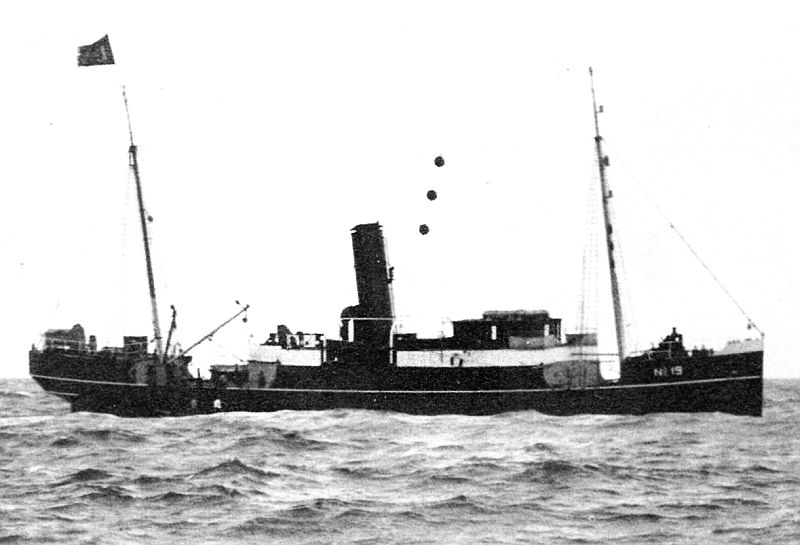 Pilot steamer 19 off the Dutch coast. Source: Rijnmond loodswezen.
Pilot steamer 19 off the Dutch coast. Source: Rijnmond loodswezen.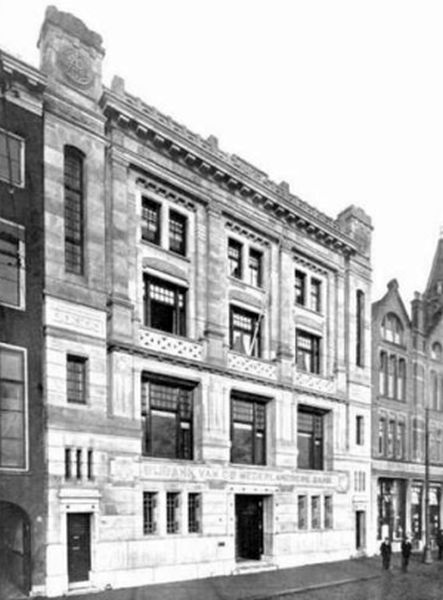 The Bijbank (sub-office) of the Nederlandsche Bank at the Boompjes in Rotterdam. Source: Nieuws top 010 Source: Nieuws top 010.
The Bijbank (sub-office) of the Nederlandsche Bank at the Boompjes in Rotterdam. Source: Nieuws top 010 Source: Nieuws top 010.HM SC 19A
Pilot steamer No. 19 was built for the Dutch pilotage at the Boele and Pot wharf in Bolnes in 1923. The ship, which was 152 feet long and 25 feet wide, generated 950 hp through its triple expansion steam engine, which propelled it through the water as fast as 10 knots (11.5 mph). The pilot vessel was hardly suited for open water, but was designed to be deployed along the Dutch coast, the sea inlets and ports. Along with pilot steamers No. 16, No. 17, and No. 18 it was assigned to the Nieuwe Waterweg district, with Maassluis as its home base port.
Before the war, its crew consisted of a senior pilot, a helmsman, three assistant pilots, six or seven apprentice pilots, four machine drivers, and four stokers. The boat, of course, was used to bring pilots to vessels entering or leaving the harbor. The pilot boats were usually active for two weeks, and inactive for one, so that the four vessels could relieve each other.
In August 1939, pilot steamer No. 19, along with the other pilot boats stationed in Maassluis, was commandeered by the Koninklijke Marine (Royal Dutch Navy) and Lieutenant 2nd class KMR (Royal Dutch Navy Reserve) Speciale Diensten (Special Forces) IJ. Smit to serve as HM Surveillance Craft 19A. The ship was equipped with two 3.7 cm (1.5") cannons, which were placed portside on the bulwark; her crew received several guns. As a surveillance craft, it was used to inspect and search suspicious vessels before they were allowed access to the Nieuwe Waterweg. This happened under the command of Luitenant-ter-Zee 2 (Lieutenant) Smit. In between military operations, the vessel was still used to pilot sea ships under the command of pilot J. Korree. HM SC 19A’s, or pilot steamer 19’s, routine operations were interrupted by a special assignment on May 10. Commissioner Van Dienst from the Hoek van Holland pilotage had suggested using the vessel for the transport of the Rotterdam gold. He had received permission from his superiors.
Contrary to the Dutch government, the British had long known that the Netherlands would never remain untouched during a new European war. Its ports were far too important for that. In London, too, it was assumed that the Netherlands would never last long against the German war machine. The British, therefore, had made preparations in the form of demolition detachments, which would be taken to IJmuiden, Hoek van Holland, and Vlissingen on torpedo destroyers, in order to demolish their installations and oil supplies before they could fall into German hands. However, the Commander in Chief of the Dutch armed forces, General Winkelman, ordered the operation to be limited to preparations only.
Meanwhile, the Nederlansche Bank had phoned the Bank of England for help, which in turn had engaged the British Admiralty. In the morning of May 10, a demolition detachment, numbering 95 men and led by Commander J.A.C. Hill, left Dover and boarded HMS Wild Swan. The destroyer arrived at Hoek van Holland at 5.30 pm, but Hill was forbidden from incinerating the oil supply at Pernis. The crew, however, were to board the HM SC 19A to secure as much of the Rotterdam gold as possible.
Definitielijst
- destroyer
- Very light, fast and agile warship, intended to destroy large enemy ships by surprise attack and eliminating them by using torpedoes.
- torpedo
- A weapon of war. A cigar shaped body fitted with explosives and a propulsion and control mechanism. Intended to target after launch a nearby enemy ship and disable it by underwater explosion.
Images
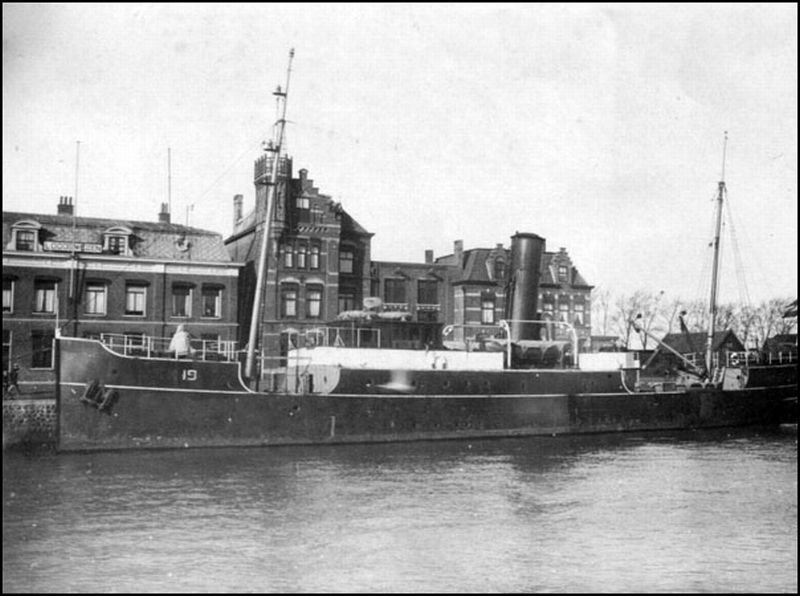 Steamer Pilot 19 in its home port, Maassluis. Source: Kustvaartforum.
Steamer Pilot 19 in its home port, Maassluis. Source: Kustvaartforum.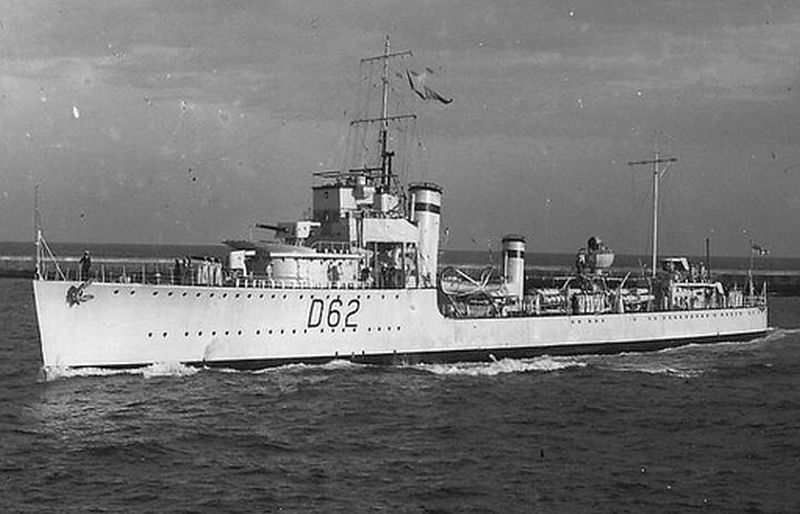 HMS Wild Swan took the British destruction crew to Hoek van Holland. Source: Wikipedia.
HMS Wild Swan took the British destruction crew to Hoek van Holland. Source: Wikipedia.Gold evacuation
In the Rotterdam Bijbank lay 937 gold bars, weighing 11 tonnes (12 US tons/ 10.8 imperial tons) and valued at 22 million guilders, packed in crates. This was not ten percent of the total store value, but it was all the bank employees could manage under heavy fire. The remaining over one hundred tonnes (110.2 US tons/ 98.4 imperial tons) would stay in the vaults. Colonel Engineer P.W. Scharroo, commander of the Rotterdam garrison, provided four trucks and a number of marines to load the gold and drive it to the Lekhaven (Lek harbour).
On May 10th, at 10.30 am, Pilot Steamer 19 moored at the Berghaven in Hoek van Holland, and was boarded by LtZ 2 IJ. Smit. He took over command from the skipper, turning the vessel into HM SC 19A. At 7.30 pm the 95 members of the demolition detachment from England boarded, and the vessel, with no time to spare, left for Rotterdam. Along the way, several sabotage groups were dropped on land, to make room for the other passengers. During the three-hour trip from Hoek van Holland to Rotterdam, the pilot crew was confronted with acts of war for the first time, such as shootings from the shore and a view of all the fires and bombardments. Once they had arrived at the Lekhaven, the remaining Brits disembarked under Commander Hill to help the Dutch navy load the gold. In total, 170 crates of gold were loaded into the four trucks.
The coordinator of the gold loading, Auditor-General for the Nederlandsche Bank W.C. Roest van Limburg, described the final stages of the operation: ‘The trucks are moving out one by one. Every time one crosses a bridge, the Germans get suspicious and open fire. When the last truck has moved out, and the last soldier has left, it is nearing dusk. We learn that the Germans have been pushed back to the Boompjes, but that they endured that night on the bridges and the left bank of the Maas. There will be attempts to expel them there as well! We are now warned for the fire that approaches our office from the east. The buildings directly across the Maasbrug (bridge) have been set on fire and this fire is nearing us on the eastern wind. We must get out of here. We leave on the Navy Commander’s signal, after having securely closed the building. Most officials rush across the bridge on foot. Finally, I left by car with Mr Lagerwey and the present women. The Germans see us off with a volley.’
Loading the gold aboard the HM SC 19A took place on May 11 from 3.00 am. The British military and the crew of the pilot ship put the crates on both sides of the wheelhouse and behind the funnel. The ship left two hours later, and on board were Ordinary Seaman Royal Navy T.G. Goshawk and F.G. Higgs, along with the twenty men strong crew. The remaining Brits returned westward, on land, to take up their destruction demolition positions.
The return voyage westward went much more smoothly than the voyage in the previous night. As day replaced night, all of the crew not on active duty called it a day, dressed in their clothes and some in their life vests. Relative peace had returned on board. The ship was making good time, and was expected back at the Berghaven at Hoek van Holland around 7.00 am. It had cleared Vlaardingen at 5.30, with the former Kruiteiland on one bank of the Nieuwe Waterweg, and the dock of the Eerste Nederlandse Coöperatieve Kunstmestfabriek (First Dutch Cooperative Fertiliser Factory), also known as the ENCK or super phosphate factory, on the other. What the crew did not know was that German aircraft had been dropping magnetic mines in the Nieuwe Waterweg from 11.00 pm the previous night. These mines were activated by a steel object crossing over them. HM SC 19A had a displacement of 584 tonnes (574.7 Imperial tons/ 643.8 US tons), which was made possible by a mostly steel hull.
Images
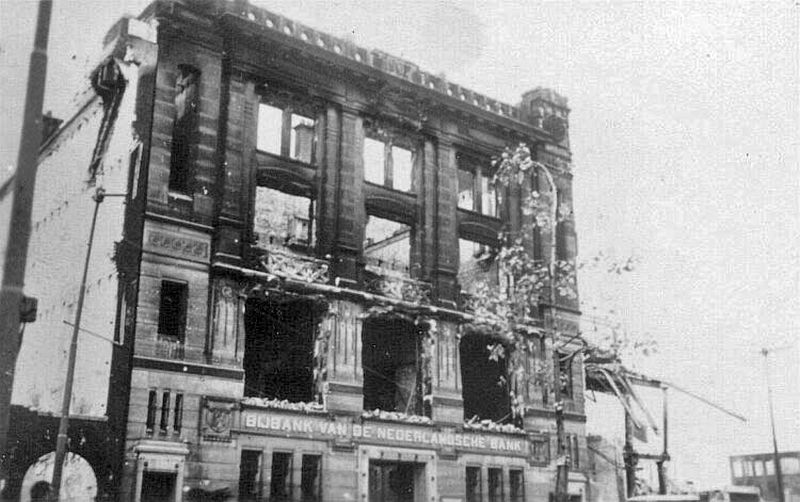 The heavily damaged Bijbank building after the fights in May 1940. Source:. Source: Rotterdam 010.
The heavily damaged Bijbank building after the fights in May 1940. Source:. Source: Rotterdam 010.The end of HM SC 19A
At exactly 5.30 in the morning of May 11, 1940, a German magnetic mine was activated at the bottom of the Nieuwe Waterweg. The explosive detached itself from the bottom, shot up, and hit the keel of the HM SC 19A under the engine room. It exploded with massive force. The vessel was pushed out of the water, decks were ripped apart, the frame is torn, and wreckage flew into the air. The bow and stern of the ship fell back into the water separately and started to sink, the bow faster than the stern. Fuel oil flowed from the wreck, which, having caught fire in some places, billowed thick clouds of smoke. After most of the ship, sizzling, crunching and squeaking, had been engulfed by the Nieuwe Waterweg, only the top of the funnel and a few metres of the foremast could be seen above the bubbling, frothing black water, surrounded by ever growing oil flames and black plumes of smoke. Immediately after the yells and screams from the crew could be heard.
From shore and the ENCK quay, bystanders and crewmen watched in horror how the disaster unfolded. A rowboat and the ship De Vrijheidsplaat, a Spido port service vessel commandeered as orderly vessel came to their aid. The captain of De Vrijheidsplaat: "The Maas had become unsafe from 11pm Friday night, due to magnetic mines that had been dropped by a low-flying aircraft in the Westgeul-Vulcaanhaven line. It was a clear night. We saw objects being dropped at intervals. At first, we thought they were parachutists. But the next day, when pilot ship 19 came from Rotterdam -it kept close to the Vlaardingen shore- we suddenly heard a loud explosion and the ship flew apart. I immediately took my ship out to help. I took four men out of the water."
The crewmen in the pilot ship’s wheelhouse had all died on instantaneously, as had the engineers in the engine room, who did not stand a chance at the explosion’s epicentre. Three men were flung from the bridge into the water. Pilot apprentice 1st class C.L. Sparling had just rolled himself a cigarette and was smoking near the funnel, seated on two small crates of gold. Without any notice, all hell had broken loose. The strange thing was that he had not heard an explosion; he had been cast upwards and squashed back on deck in complete silence. He then felt himself sinking as pieces of wreckage hit his head, and was tossed into the starboard gutter. He jumped overboard when that part of the ship sank. A part of his calf had been ripped from his leg and a piece of shrapnel protruded from a wound in that same leg. With great difficulty he swam for a sinking dinghy and clung to it.
Pilot apprentices B. Spuij, C. Swart and W.J. Pottinga, (who was badly injured) escaped from the apprentices’ quarters. Assistant pilot R. Koudenburg and helmsman W. Goos were the sole survivors of the explosion. Sparling’s leg injury was so bad that it took several operations to save it. Koudenburg suffered a concussion, a skull fracture, a broken shoulder, and a broken leg. He spent several months recuperating, but never fully healed recovered. Some oil had got behind his eye and it would torment him for the rest of his life. Helmsman Good injured his head and spent weeks with his leg in a cast. Pottinga lost a few teeth and had to recover from injuries to his side and leg for fifteen years. Only Spuij and Swart escaped with only mental and physical damage.
Definitielijst
- mine
- An object filled with explosives, equipped with detonator which is activated by either remote control or by colliding with the targeted object. Mines are intended to destroy of damage vehicles, aircrafts or vessels, or to injure, kill or otherwise putting staff out of action. It is also possible to deny enemy access of a specific area by laying mines.
Images
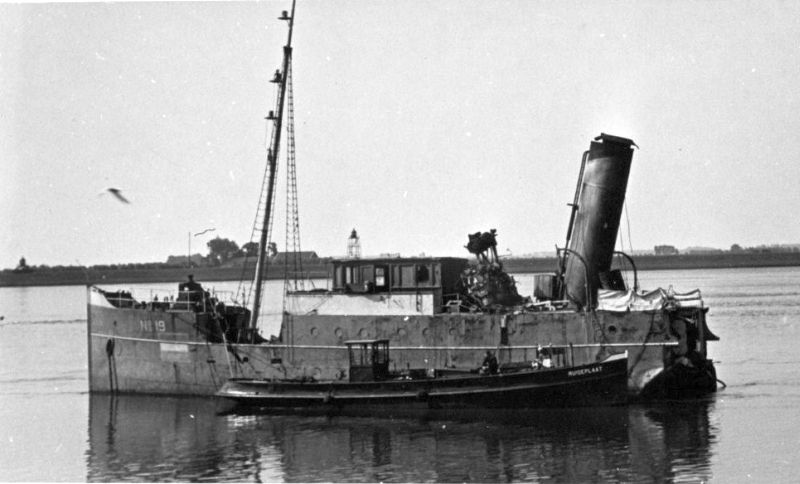 The front part of the HM SC 19A wreck. Source: Historiek.
The front part of the HM SC 19A wreck. Source: Historiek.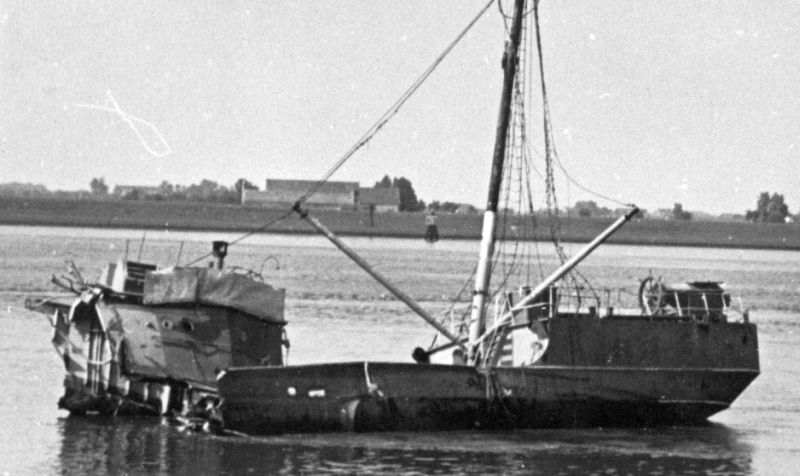 The stern of HM SC 19A after salvaging. Source: Historiek.
The stern of HM SC 19A after salvaging. Source: Historiek.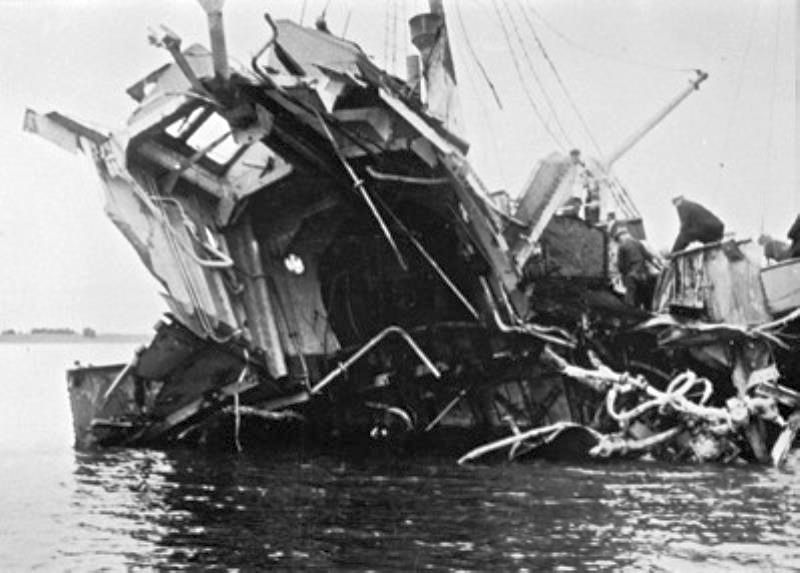 A heavily damaged part of pilot ship 19’s wreckage. Source: Maritiem Digitaal.
A heavily damaged part of pilot ship 19’s wreckage. Source: Maritiem Digitaal.Lost gold
During the explosion, most of the chests were splintered, and the gold inside had sunk to the sandy bottom of the Nieuwe Waterweg. At the capitulation on May 14 it was decided that any wreckage that could hinder shipping had to be salvaged or cleared as soon as possible. On May 31, 1940 W.A. Van den Taks Bergingsbedrijf (salvaging company) was ordered to clear the wreckage of pilot ship 19 and its cargo. The next day, two divers were at the scene, and they soon observed that the ship had broken in two. The bow was salvaged on June 13, the stern followed four days later.
At the recovery and demolition of the wreckage 776 gold bars were recovered. 161 were still missing. It was soon decided to turn to dredging to recover the missing bars. From September 24, this was taken up by dredging company Adriaan Volkers Mij. in Sliedrecht. Another forty bars were found in a week’s time. The salvage operation was supervised by the Rijksveldwacht from Vlaardingen, and every find was recorded. The lost gold was claimed by Germany, however, and sent to Berlin in April 1941. That confiscation gave cause to stop the dredging.
After the liberation the lost bars of gold probably passed into oblivion, as it took until summer 1946 for anyone to bring them up again. The reason for the new interest in the gold was the discovery of a gold bar during dredging activities near Kruiteiland, at the end of June that same year. Between June 27 and Juli 6 another nine bars were dredged up. These coincidental finds motivated the Nederlandsche Bank to organise an active search for the rest of the gold.
The Nederlandsche Bank entered into an agreement with contractors Adriaan Volker and Den Breejen van den Bout. Operations started in early April 1947. Within a month, 100 bars of gold were found in the Schelde’s dredging buckets and the sand dredger Sliedrecht IX sand dredgers. Another lone bar of gold was found at the end of May. By then, only ten bars were still missing. Dredging operations were terminated on June 9.
The dredging for gold received barely any police supervision. This was contrary to the search for gold during the occupation. It is, then, not surprising that a number of gold bars was embezzled during ’46 and ’47. The case of the three missing bars came to light when an accountant was filing one of the fence’s tax returns. He convinced one of the buyers to file a police report, which led to the arrest of several dredgers. While interrogating them, it emerged that two other bars had been stolen, one of which was traceable. The third bar turned up in Belgium. A year later, a fourth came to light, so that the total of missing bars came to six. Today, these would be worth approximately 2,5 million euros. They could still be at the bottom of the Nieuwe Waterweg, or unwittingly have been used for the embankment of the Spaanse Polder.
Definitielijst
- capitulation
- Agreement between fighting parties concerning the surrender of a country or an army.
Images
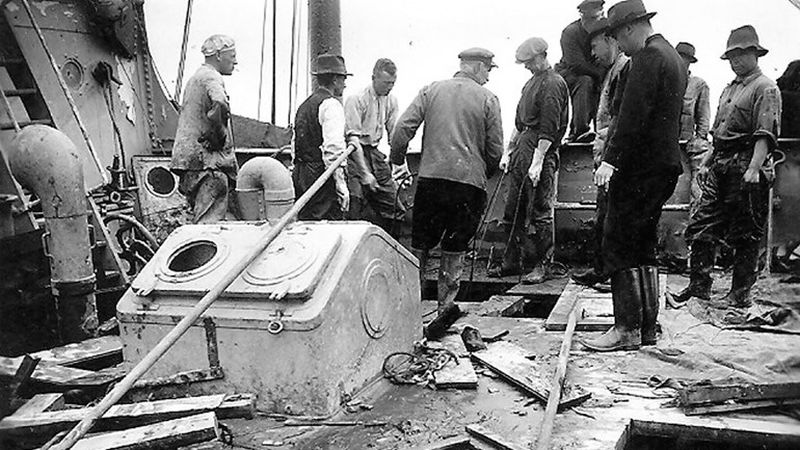 Dredgers on deck of the salvaged HM SC 19A. Source: Rijnmond.
Dredgers on deck of the salvaged HM SC 19A. Source: Rijnmond.Crew list HM SC 19A on May 11, 1940
Deceased:
Lieutenant Commander 2nd class IJ. Smit
Pilot skipper 1st class J. Koree (51) Assistant pilot J. Drijver (31)
Assistant pilot C. v.d. Horst (34)
Apprentice pilot 2nd class J. Harinck (25)
Apprentice pilot 2nd class K. v.d. Meer
Machine driver J.J.J. de Glopper
Machine driver D. de Boer (44)
Machine driver S. Antonius
Machine driver F. Rolsma (55)
Stoker 1st class J. van Dok (52)
Stoker 1st class J.W. Pols (50)
Stoker 1st class P. v.d. Struis (45)
Stoker 1st class M. Voogd (37)
Commander J.A.C. Hill R.N. (39)
Ordinary Seaman T. Goshawk RN
Ordinary Seaman F.G. Higgs RN
Survivors: Helmsmaan W. Goos (badly injured)
Assistant pilot R. Koudenburg (badly injured)
Apprentice pilot 1st class C.L. Sparling (badly injured)
Apprentice pilot 1st class C. Swart
Apprentice pilot 2nd class W.J. Pottinga (badly injured)
Apprentice pilot 2nd class B. Spuij
HM SC 19A had sunk and seventeen people had died attempting to save 11 tonnes of gold. Many more people lost their lives for far less important reasons during the war, but the history of pilot ship 19 remains a macabre one. Comptroller-General Roest van Limburg stated as follows: "I dropped off the passengers of the car in several locations throughout the city, arrived at home around 7 pm, and had only one thing on my mind: sleep, sleep, and forgetting about the nightmares of the war for a moment. I had barely gone to bed before the harbour master called to inform me that the pilot ship with the gold had struck a mine. The entire crew, consisting of young volunteers, apprentices, all dead, save three. Our only possible satisfaction, that we may have saved the bars of gold at least, was gone. There was no victory here, only the loss of young men’s lives."
Definitielijst
- mine
- An object filled with explosives, equipped with detonator which is activated by either remote control or by colliding with the targeted object. Mines are intended to destroy of damage vehicles, aircrafts or vessels, or to injure, kill or otherwise putting staff out of action. It is also possible to deny enemy access of a specific area by laying mines.
Information
- Article by:
- Peter Kimenai
- Translated by:
- Nadia Guntlisbergen
- Published on:
- 28-07-2019
- Last edit on:
- 30-09-2024
- Feedback?
- Send it!
